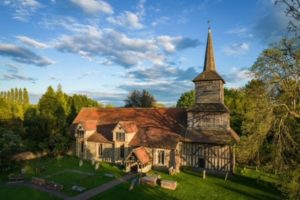Visit Us
If you would like to visit our historic church building outside of our regular services or other events please call Stuart on 01277 821078 or John on 01277 821805.
We are always happy to welcome visitors and there is no charge.
You can view our guidebook here
The Priory Church of St Laurence dates back to around 1170. Architecture from this period can still be seen at the west end of the Nave, in the doorway to the Tower and the arches up in the walls north and south of the West End. Richard, Bishop of London (1155-62) gave authority for the foundation of the priory for a prior and 12 canons of the Augustine Order.
There are indications that the original priory church had a lofty nave with side aisles which had lean-to roofs at a lower elevation. There is a string on each outer side of the west end arches where the side aisles roofs rested. The west wall of the nave was an outside wall and the Norman doorway was the main entrance. The Priors worshipped regularly each day. Their route through the cloisters into church was illuminated by means of a cresset stone.
The bell tower was built in 1400. It is one of the finest of its kind and houses five bells.
Blackmore Priory was one of the first monastic establishments to be dissolved by Henry VII. It was granted with its endowments to Cardinal Wolsey. Later it was returned to the Crown (1529). Next it was given to Waltham Abbey (1531) which later was dissolved with other larger monasteries and our priory was returned to the Crown.
John Smyth bought the Priory from Henry VIII in 1540. He was auditor to the King. The Smyth family were to hold an influential place in the life of the village for five generations, through to 1721. Various inscribed slabs in the floor of the Church indicate a succession of Smyths.
The north and south dormer windows and the brick piers and arches of the south arcade belong to the Tudor period, but we do not know whether they were built before the period of destruction or were part of the reinstatement. From 1600 to the present time there have been no major structural alterations.
Blackmore’s Parish Registers of Baptisms, Marriages, and Burials date from 1602.
In 1877 and 1898 – 1902 extensive restorations were carried out. In 1905 a carved wooden screen was erected at the entrance to the chancel. This will now be seen on the north side of the chancel enclosing the vestry, having been moved in 1988.
Kitchen and toilet facilities were created in the north west corner in 1990 and a Children’s corner in the south west corner in 2005.
Further history and information is available on these external links (will open in new tab):
Historic England
Wikipedia
Local Historian Andrew Smith
British History Online
Explore Churches

